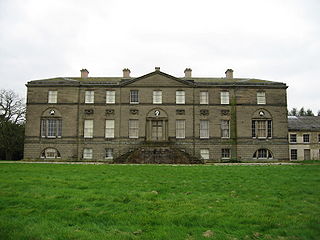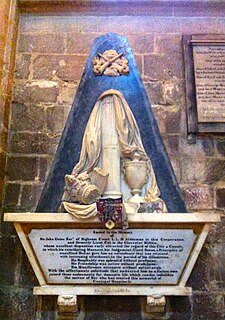Related Research Articles

Earl of Kimberley, of Kimberley in the County of Norfolk, is a title in the Peerage of the United Kingdom. It was created in 1866 for the prominent Liberal politician John Wodehouse, 3rd Baron Wodehouse. During his long political career, he notably held office as Lord Lieutenant of Ireland, Secretary of State for the Colonies, Secretary of State for India and Secretary of State for Foreign Affairs. He was succeeded by his son, the second Earl. At first a Liberal like his father, he later joined the Labour Party, becoming the first Labour member of the House of Lords. His eldest son, the third Earl, represented Norfolk Mid in the House of Commons as a Liberal. Since 2002, the titles are held by the latter's grandson, the fifth Earl.
Baron Huntingfield is a title that has been created three times, twice in the Peerage of England and once in the Peerage of Ireland. The first two creations were by writ, but little more is known about them, except that John de Huntingfield, who was created Baron Huntingfield in 1362, married Margery de Welles, daughter of John de Welles, 4th Baron Welles. John was dead by December 1376, when Margery remarried. Both titles probably became extinct or fell into abeyance on the death of their first holders. The third creation, Baron Huntingfield, of Heveningham Hall in the County of Suffolk, was created in the Peerage of Ireland in 1796 for Sir Joshua Vanneck, 3rd Baronet, Member of Parliament for Dunwich. His son, the second Baron, also represented this constituency in the House of Commons. His great-grandson, the fifth Baron, was Conservative Member of Parliament for Eye and Governor of Victoria. As of 2013 the titles are held by the latter's grandson, the seventh Baron, who succeeded his father in 1994.

Baron Hesketh, of Hesketh in the County Palatine of Lancaster, is a title in the Peerage of the United Kingdom. It was created in 1935 for Sir Thomas Fermor-Hesketh, 8th Baronet, who had previously briefly represented Enfield in the House of Commons as a Conservative. As of 2010 the titles are held by his grandson, the third Baron, who succeeded his father in 1955. Lord Hesketh held junior ministerial positions in the Conservative administrations of Margaret Thatcher and John Major. However, he lost his seat in the House of Lords after the House of Lords Act 1999 removed the automatic right of hereditary peers to sit in the upper chamber of Parliament.

The Broughton, later Broughton-Delves, later Broughton Baronetcy, of Broughton in the County of Stafford, is a title in the Baronetage of England. It was created on 10 March 1661 for Sir Brian Broughton, of Broughton Hall, near Eccleshall, Staffordshire, High Sheriff of Staffordshire from 1660 to 1661 and the member of an ancient Staffordshire family.
There have been five baronetcies created for persons with the surname Clarke, two in the Baronetage of England and three in the Baronetage of the United Kingdom. Two of the creations are extant as of 2010.

There have been ten baronetcies created for persons with the surname Browne, six in the Baronetage of Great Britain, three in the Baronetage of Ireland and one in the Baronetage of Nova Scotia. Only one creation is extant as of 2010. Three of the creations were for members of the Browne family headed by the Viscount Montagu.
Nineteen baronetcies have been created for persons with the surname Hamilton, eight in the Baronetage of Nova Scotia, one in the Baronetage of England, five in the Baronetage of Ireland, one in the Baronetage of Great Britain and four in the Baronetage of the United Kingdom. As of 2008 two creations are extant, two are dormant, two are either extinct or dormant and twelve extinct.

Sir Theodore Janssen of Wimbledon, 1st Baronet was a French-born English financier and Member of Parliament who, after a long and successful career in commerce, was ruined and disgraced by his part in the South Sea Bubble.

There have been twenty baronetcies created for persons with the surname Williams, eight in the Baronetage of England, three in the Baronetage of Great Britain and nine in the Baronetage of the United Kingdom. Only five of the creations are extant as of 2017..
The Broadhead, later Brinckman Baronetcy, of Burton or Monk Bretton in the County of York, is a title in the Baronetage of the United Kingdom. It was created on 30 September 1831 for Theodore Broadhead, Member of Parliament for Yarmouth. In 1842 he resumed by Royal Licence the old family surname of Brinckman in lieu of his patronymic. Brinckman was the son of Theodore Broadhead, who also represented Yarmouth in the House of Commons, son of Theodore Broadhead, High Sheriff of Surrey in 1786, who assumed the surname of Broadhead in lieu of Brinckman by Act of Parliament. The latter's grandfather Theodore, Baron Brinckman, had emigrated to Britain from Hanover. The first Baronet was succeeded by his eldest son, the second Baronet. He sat as Liberal Member of Parliament for Canterbury. His grandson, the fourth Baronet died childless in 1954 and was succeeded by his younger brother, the fifth Baronet. The latter was a colonel in the Grenadier Guards, Aide-de-Camp to the Governor of Victoria and to the Governor-General of Canada and Chief of Staff to the British Military Mission in Moscow during the Second World War.

There have been two baronetcies created for the Guise family, one in the Baronetage of England and one in the Baronetage of Great Britain. The latter creation is extant as of 2014.

There have been seven baronetcies created for persons with the surname Russell, three in the Baronetage of England and four in the Baronetage of the United Kingdom.
There have been six baronetcies created for persons with the surname Thomas, three in the Baronetage of England, one in the Baronetage of Great Britain and two in the Baronetage of the United Kingdom. Two of the creations are extant as of 2016.

There have been two baronetcies created for the Knowles family, originally a branch of the Knollys family known as Knollys of Stanford. One is in the Baronetage of Great Britain, which is extant, and one in the Baronetage of the United Kingdom, which is extinct.
There have been four baronetcies created for persons with the surname Hay, all in the Baronetage of Nova Scotia. Two creations are extinct, one dormant and one extant. A fifth baronetcy in the Jacobite Peerage, although theoretically extant, is not recognised by the Lyon Office.

There has been six baronetcies created for persons with the surname Shaw, one in the Baronetage of England, one in the Baronetage of Nova Scotia and four in the Baronetage of the United Kingdom. Two of the creations extant as of 2010.

There have been five baronetcies created for persons with the surname Morgan, two in the Baronetage of England, one in the Baronetage of Great Britain and two in the Baronetage of the United Kingdom. All five creations are extinct.

There have been three baronetcies created for persons with the surname Meredith, one in the Baronetage of England, one in the Baronetage of Nova Scotia and one in the Baronetage of the United Kingdom. Two of the creations are extinct while one is dormant.
Sir Abraham Janssen, 2nd baronet, of Wimbledon, Surrey, was a British politician who sat in the House of Commons from 1720 to 1722.
Sir Stephen Theodore Janssen, 4th Baronet was an English Member of Parliament and Lord Mayor of London.
References
- ↑ Cokayne, George Edward (1906). Complete Baronetage. Vol. V. Exeter: W. Pollard & Co. pp. 26–27. LCCN 06023564.